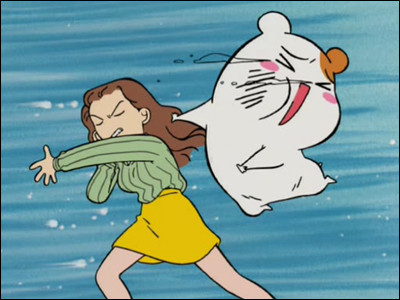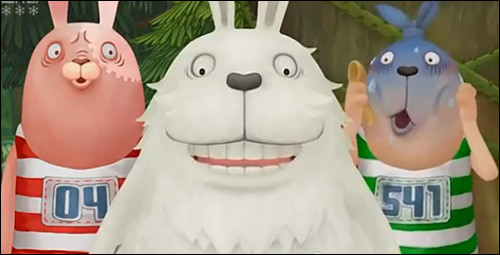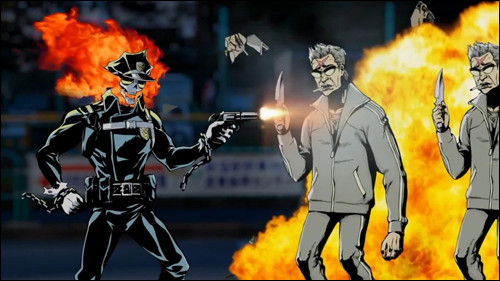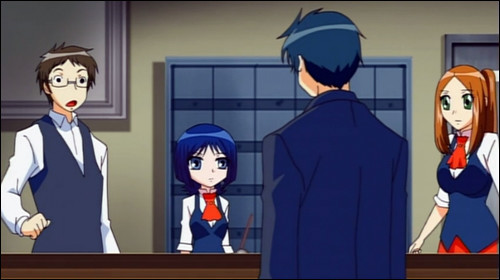The Mike Toole Show
Coming Up Short
by Michael Toole,
Like a lot of you dorks, I watch anime pretty much every single day. I watch TV shows, OVAs, movies-- you know, whatever I can cram in during my free time. The thing is, I'm a grown-up with a career and responsibilities (or so they tell me—dunno about you guys, but I generally still think of myself as being nine years old), so there are some days when my free time just doesn't add up to much at all. But even on days like these, I can usually cram a few minutes of anime-watchin' time in-- because, as it turns out, there's anime every season that only run a few minutes per episode!
Yep, what I'm into this time around is short TV anime, a product that's been around for awhile but grown up a bit in recent years, especially with the rapid evolution of CG. But short TV anime-- generally, stuff that runs fifteen minutes or less per episode-- is something that's been kicking around since the 1990s. We haven't seen altogether too much of it on these shores, since it's a little harder to package for western TV and video, where the expectation is still something that can be wedged into 30-minute blocks once you add commercials. But what are some good short TV anime? Let's check it out!

The thing is, the 15-minutes-or-less format is by no means a new phenomenon; it's fairly common for sitcoms to employ it. Urusei Yatsura presented two dumb 12-minute stories per 24-minute episode for its first season, before switching over to 25-minute stories. My old fave Galaxy Angel employs the formula as well, and the recently-ended gag comedy Polar Bear's Café also takes this approach. But ultimately, these shows still just double up to make a half-hour. What's shorter than that? Ippatsu Kiki Musume is shorter than that!
Ippatsu Kiki Musume (translated as “Miss Critical Moment,” an awesome title in either language) was my first experience with shorter-than-usual TV anime. I viewed it sometime in 2000, on my computer—yep, it was my first experience with digital fansubs. I didn't take a chance on Kiki Musume because it was something radically different than the norm, however, but because its short length meant that the files were smaller. There was less bandwidth to go around back then.
Ippatsu Kiki Musume's sixteen episodes are all over in under five minutes each, and follow a simple formula: the pretty Kunyan finds herself in some sort of awful, life-threatening predicament, and must work out an equally improbable escape while the narrator, played by narrator extraordinaire Tesshō Genda, briskly explains the circumstances of her impending and horrible death. My favorite episode involves Kunyan being devoured by a pal's 24-foot pet python; her eventual escape involves farting into a balloon while shouting “JESUS!” Other episodes involve impending doom courtesy of burning buildings, cramped phone booths, heavy pieces of furniture, and lots of nudity for no particular reason.

At the same time Ippatsu Kiki Musume fansubs were leaking out on VHS(!) and over the internet, there was another short comedy that hit the fansub circuit: Sexy Commando Gaiden: Sugoi yo!! Masaru-san. Masaru-san is so packed with catchphrases and cultural references that it's sometimes hard to follow, and its shrewdly calculated ugliness makes it a visual standout as well. Naturally, these attributes have made it a cult hit in Japan, where the manga ran in Shonen Jump and the anime got a DVD release. I doubt Masaru-san's emergence in the fansub circuit at the same time as Ippatsu Kiki Musume is accidental, since both of 'em ran as part of an anime block called Wonderful. Anyway, Masaru-san, directed by the generally excellent Akitaroh Daichi, set the standard for “seemingly decent high school kid kid is roped into den of weirdos” trope that later hits like Haruhi Suzumiya and Cromartie High School would exploit. Its comedy is hellishly rapid-fire, and visually it looks like the scrawls on a junior high school kid's notebook come to life. I recommend it.
A few bits of the Wonderful omnibus did make it to our shores. I've mentioned the fine Di Gi Charat before, and while fare like Pet Shop of Horrors and the You're Under Arrest TV specials were wedged into this block, they don't really fit the mold established for this column. But Colorful does! Colorful is sixteen five-minute vignettes about men and the ladies' underpants that they love. I like the character designs in this one, courtesy of Takahiro Kishida – they're restrained and fairly realistic, which clashes with the bawdy, darkly comic stories of men behaving like imbeciles in the service of catching glimpses of women's undergarments. My favorite slice of Colorful skips that noise in favor of two dopes goading their pretty English teacher into repeating a lesson about the difference between L and R, so they can stare at her mouth while she talks. Ultimately, Colorful, which did come out on DVD in these parts, is a heartwarming affair about how there's freaks everywhere you look. Try not to confuse it with the new motion picture called Colorful, which is a bit more tasteful.

Colorful, Masaru-san, and Ippatsu Kiki Musume were all part of the same program block. But Wonderful wasn't the only anime omnibus show out there—over at DirecTV Japan, there was a similar 30-minute affair called Anime Ai no Awa Awa Hour. Two of the show's segments, Little Women in Love and Here Comes Koume!, never really made it beyond Japan. But the show's signature segment, which did make inroads amongst anime fans overseas, is Ebichu the Housekeeping Hamster. The show's allure is obvious—it's cute like Hamtaro, only amusingly filthy, the story of a bored office lady's Pollyanna-ish pet hamster, who pines for her mistress in the face of endless crude remarks and violence. The show's language was bad enough that it got bleeped on Japanese TV, a phenomenon that I can't recall ever seeing elsewhere. The comedy is a bit one-note—if you see one segment, you've just about seen 'em all—but without Ebichu, we probably wouldn't have an entire Wikipedia category called “fictional hamsters.”
There was Wonderful and Anime Ai no Awa Awa Hour, and then there was Anime Complex. All three of these omnibus shows were more or less concurrent, airing between 1998 and 2001. Anime Complex is notable to me, because unlike everything else on this list, it includes action and science fiction as well as comedy. I think the short format is a bit better suited for comedy, but hey, variety is the spice of life. Anime Complex brought us fan favorites like The Adventures of Mini-Goddess and and Steel Angel Kurumi, as well as fansub oldies such as Rizelmine. (Yep, I just called a digital fansub an “oldie.”) One of the broadcast's centerpieces, Neo Ranga, is a fairly decent weird occult action thing, which came out courtesy of ADV Films, but my favorite of the block's shows is Kurogane Communication.

Kurogane Communication, even at the point of its release, was pretty underrated. This set of fifteen-minute episodes got lost in the shuffle of the go-go early 2000s anime DVD boom, but it's a surprising little tale of life after the apocalypse, as a young girl named Haruka searches a ruined world for other human survivors (she just might be the only one). Fortunately, Haruka does have friends—but they're all sophisticated robots left over from humanity's last great war. The show is engaging and takes some risks—Angela, who looks a bit like Kusanagi from Ghost in the Shell, is sufficiently belligerent and suspicious of humankind, but the Terminator-looking Reeves is a sweet-talker who specializes in cooking and domestic duties. Media Blasters released this back in the day, and like so many other good titles, it's out of print.
We tend not to think of it that way, because it wasn't packaged as five-minute episodes in North America, but the great high school comedy Azumanga Daioh was originally broadcast as shorts in Japan. Given its roots as a 4-panel gag strip, that makes plenty of sense. AzuDai came to life as animation in the form of a couple of original net animations in 2000. These helped establish demand for the franchise, and so were followed by a quickie 6-minute movie and the TV series, featuring all of our favorites like quiet girl, child prodigy girl, Master Shake girl, Meatwad girl, and Frylock girl.

Don't you dare tell me the comparison doesn't make perfect sense! Anyway, it worked like this: TV Tokyo and AT-X and their regional pals broadcast little 5-minute episodes of Azumanga Daioh on weekdays, and then the “full” 25-minute episode would land on the weekend. Neat, huh? It's a testament to just how well-planned and properly executed the series really was, because it feels completely natural in both 5-minute bites and 25-minute chunks.

More than anything else on this list, Usavich is the perfect example of why I wrote this column. The creation of director Satoshi Tomiaki and artist Aguri Miyazaki, Usavich (a play on “usagi” or “rabbit” and the Russian “–vich”) is an ongoing series of unrepentantly bizarre, almost dialogue-free 90-second segments featuring a pair of rabbits, first in some sort of surreal Soviet-themed prison, and later on the road to escape together. It was created for MTV Japan, which means that its exposure in the west is sadly limited—you can get DVDs of it in Australia, but not in my neck of the woods. I mention it to other fans sometimes, and it seems to me that it's largely unknown, which sucks! Usavich is the sort of series that makes me fall in love with animation all over again—it walks and talks like practically no other cartoon out there. Some sort of legal streaming option would be boffo, but until then, there's always YouTube.
Just as I was discovering how well anime comedy worked in sub-15-minute form with fare like Ippatsu Kiki Musume, Cartoon Network were having a similar successful experiment with the rollout of their Adult Swim programming block. I responded to that, too—hell, Adult Swim is what made me subscribe to cable TV. Its collection of mostly brief, clever parodies and original shows like Sealab 2021 and Aqua Teen Hunger Force seemed to really nail good comic formula. If there's one anime I've seen that reminds me of Adult Swim shows, it's Astro Fighter Sunred. When you see the OP for this franchise of 15-minute episodes, it brings to mind classic costumed hero fare like Inazuman and Hurricane Polymar. Then the episode actually starts, and the formula is turned on its head.

See, the titular Sunred may be an unimpeachable ally of justice, who fights for the good of all. But he also curses, chain-smokes, drinks cheap beer out of the can, gambles, and squabbles with his well-meaning girlfriend. He's got the visage of a hero, with a bright red Sentai-esque helmet (he eats and drinks straight through the thing), but eschews the rest of the costume in favor of grubby shorts and ugly t-shirts. His evil adversaries, the Kawasaki Branch of the Florsheim Empire, set an amazing contrast—they may be evil conquerors, but they're extremely polite, affable, and responsible people. My favorite is the powerful Armor Tiger, Florsheim's toughest fighter, who lives in mortal terror of his fussy, noise-averse neighbor. There's 52 episodes of this fairly excellent parody, and it bums me out that you can't just watch 'em on Hulu. If you ask me, Williams Street needs to get on the case and dub this show themselves.
We're moving into more recent territory. Yurumates3Dei is recent enough that it's still streaming on Crunchyroll. Another comedy based on 4-panel gag manga, it concerns Yurume Aida and her roomates (get it?!) in a crummy little apartment house. Yurume is a nice kid, but she flunked the college entrance exam. She wants to have another stab at it, but her dopey roomates, who are in the same circumstances, keep finding ways to distract her. Out of all of the shows on this list, Yurumates3Dei feels almost too short—I actually like the jokes, but the OP and ED bits are longer than the actual show. Still, if you keep your finger on the button and skip past 'em, Yurukates3dei has some good comedy in the middle.

I didn't believe my colleague Dave Cabrera when he said that gdgd Fairies was a powerful show. I was skeptical when Daryl Surat described it as “dangerous.” But remarkably enough, this candy-colored CG romp is Most Dangerous! On the surface, gdgd Fairies looks like the misadventures of a stereotypical trio of magical little girls—pkpk is the naïve, sweet regular girl, shrshr is the spunky troublemaker, and krkr is the weird, quiet one. But once these pleasant stereotypes are established, the show turns into a gallery of high-octane weirdness, as the three fairies use their magical powers to summon a variety of ugly CG models and utilize the “dubbing lake” to apply their own comedy dialogue to surreal scenes, like a gorilla dancing in a bathrobe or an unattractive woman in sexy lingerie. There's a time travel gag in the second season that takes several episodes to resolve. The show punches way above its weight—using simple animation software, it took creator Sōta Sugahara and his team less than a week to produce each episode, but it's still good stuff.

We're in the final lap! I've talked about this one, which sadly just wrapped up. But what will I have to live for now that Inferno Cop is over?! The debut headlining work from TRIGGER, the great Hiroyuki Imaishi's new studio, Inferno Cop feels like the crew looked at webcomic hit Axe Cop and asked themselves “How can we do this, only less refined?” Inferno Cop, the barely-animated tale of a valiant, flaming-skulled police officer's surreal trip through hell is like quick hits of comedy nitrous oxide. Episodes clock in at about two and a half minutes, and feel like they were created by no more than two people, despite the voluminous and obviously made-up credit rolls. TRIGGER have wisely released Inferno Cop for free on YouTube, and it's slowly turning into a viral sensation—episode 1 just zoomed past 100,000 views. Is there an Inferno Cop 2 in store for us down the road?! We'll see!

Last but not lea—you know what? I think this one might actually be least, guys. Have any of you seen this thing called Sparrow's Hotel? It's only Crunchyroll. Episodes—all 3 of them, since it's currently running—are around 3 minutes long. The ANN preview crew seem to think it's an ode to cheap, awful mid-1990s OVAs, but I think it's better/worse. This show, about a hotel's pretty, shapely female bouncer/housekeeper/concierge/whatever, feels like it's either a rushed student project or something calculatedly awful and evil. Watching it is like drinking off-brand beer or eating the generic version of Twinkies—you know it's gonna be bad, but you can't resist. And hey, no matter how bad it is, it's all over in three minutes, right? Let's all watch this episode! …ugh. Alright, let's watch another!
That's what I've got for you this week. I'm happy to see short-form TV anime flourish like this, because it's given rise to some remarkably creative stuff. I like reliably cool shows like Gargantia, but it's always good to have some variety. Do you guys like short TV anime? Are you mad that I didn't talk about I'll See you in my dreams, Iketeru Futari (another old fansub favorite that never made the jump to US DVD!), or Gregory Horror Show? Let me know in the comments. And finally, here's a homework assignment for you all. TRIGGER, the Inferno Cop gang, have just released their first OVA, Little Witch Academia, for free on YouTube. It's their present to the world, and I insist that you watch it! It's neat and beautifully animated and in full 1080p. Yoh Yoshinari directed it, but if you ask me it's got Imaishi's grubby fingerprints all over it. There's gonna be a quiz, so study hard!
discuss this in the forum (18 posts) |